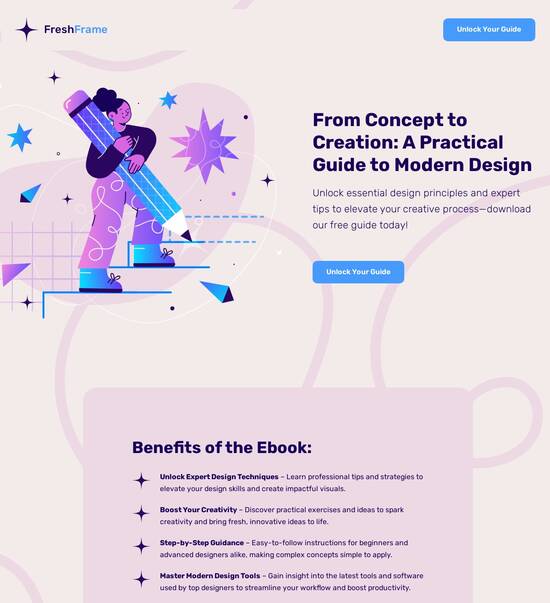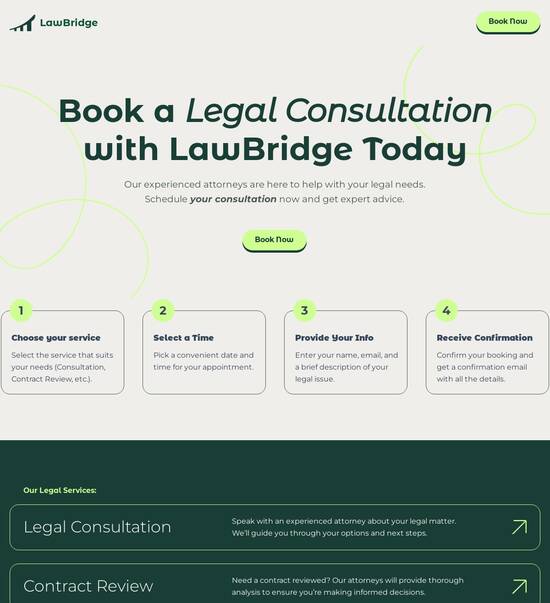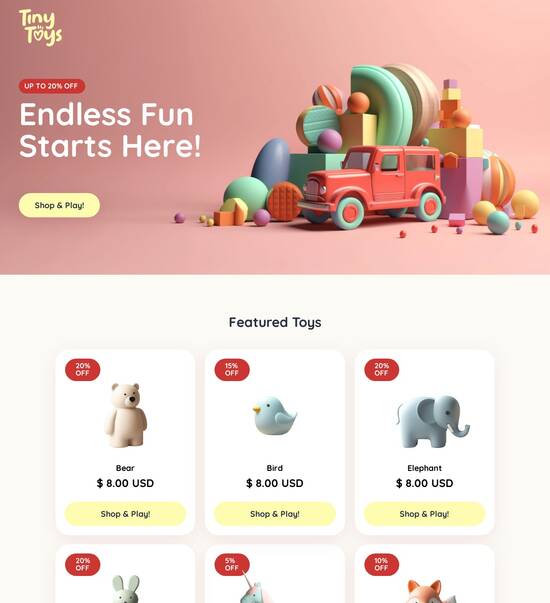
Next.js optimized contact us page template
Explore Similar TemplatesAbout template
Supercharge your contact us page with Next.js for outstanding performance! Learn more today.
Recommended templates

Easy to build without coding
With the intuitive drag-and-drop builder, anyone on your team can create high-converting pages without any knowledge of code or design. Make enhancements to your landing page with custom widgets using Javascript, HTML/CSS, or third-party scripts.

Multiple layouts for any industry and goal
Select from 500+ landing page layouts built to boost conversions across industry-specific scenarios. Customize them by adjusting fonts, adding images, and generating on-brand content with the AI assistant. Quickly scale with Instablocks® and Global Blocks that you can save, reuse, and update globally.

Loads fast and looks polished on any device
Every template is responsive, which means they present professionally on any device and load blazingly fast with our Thor Render Engine. You can also power them up with Google AMP technology to deliver an unparalleled mobile experience and drive higher conversions.

Robust analytics & experimentation
Get real-time updates and reporting across all your devices, showing the number of visitors, conversions, cost-per-visitor, and cost-per-lead. Launch AI-powered experiments, run A/B tests, and use heatmaps to analyze user behavior, then optimize your landing page to maximize conversions.







Easy to build without coding
With the intuitive drag-and-drop builder, anyone on your team can create high-converting pages without any knowledge of code or design. Make enhancements to your landing page with custom widgets using Javascript, HTML/CSS, or third-party scripts.
Multiple layouts for any industry and goal
Select from 500+ landing page layouts built to boost conversions across industry-specific scenarios. Customize them by adjusting fonts, adding images, and generating on-brand content with the AI assistant. Quickly scale with Instablocks® and Global Blocks that you can save, reuse, and update globally.
Loads fast and looks polished on any device
Every template is responsive, which means they present professionally on any device and load blazingly fast with our Thor Render Engine.
Robust analytics & experimentation
Get real-time updates and reporting across all your devices, showing the number of visitors, conversions, cost-per-visitor, and cost-per-lead. Launch AI-powered experiments, run A/B tests, and use heatmaps to analyze user behavior, then optimize your landing page to maximize conversions.
All the features you need to build lead-generating landing pages
Explore more featuresLearn how to build top-performing landing pages for any goal
FAQs
Leading the way in building high-performing landing pages





Maximize your ROI with Instapage's powerful landing page and CRO platform
Developing high-converting landing pages is essential for digital marketing success. Instapage offers an intuitive platform that allows marketers from various sectors, including business services, education, and tech, to seamlessly create landing pages that resonate with their unique audiences. With a rich library of templates and collaboration tools, you can accelerate your campaign efforts and achieve superior return on investment.
Step 1: Choose from high-converting templates
Begin your journey by selecting from over 100 pre-built, conversion-focused templates. Instapage offers a selection that caters specifically to your industry's needs, ensuring that you don't start from scratch. These customizable templates not only save time but also help in maintaining brand consistency.
- Conversion-focused design
- Every template is designed with modern user experiences in mind, enhancing user engagement and boosting lead generation.
- Customization options
- Easily modify templates to fit your branding and messaging, ensuring alignment with your marketing strategy.
- Mobile responsiveness
- All templates integrate responsive design principles, optimizing the user experience across devices.
Step 2: Optimize for high conversions
Optimization lies at the core of Instapage’s platform. Utilize built-in experimentation features to continuously refine your landing pages for better performance.
- A/B testing
- Conduct A/B tests on different elements of your landing page to identify what resonates best with your audience.
- Heatmaps
- Leverage heatmaps to visualize user behavior on your page, making it easier to spot areas for improvement.
- Analytics dashboard
- Monitor performance metrics in real time, allowing for agile marketing adjustments.
Step 3: Personalize for targeted engagement
Personalizing content can drastically improve conversion rates. Use Instapage’s dynamic text replacement and AdMaps to tailor your messages to specific audience segments.
- Dynamic content delivery
- Automatically adapt content based on user data to create a more personalized experience.
- AdMaps alignment
- Align specific ads to their respective landing pages to ensure a cohesive and targeted marketing approach.
- Audience tracking
- Utilize metrics tracking to understand how different audience segments interact with your content.
By following these steps, you can develop high-performing landing pages that not only look great but also convert effectively. Instapage simplifies the entire process, empowering marketers to enhance their campaigns quickly and efficiently.
Take the next step in your digital marketing journey with Instapage and watch your conversion rates soar.
Ready to elevate your marketing strategy? Start building your optimized landing pages with Instapage today and join the ranks of successful marketers.
Next.js optimized contact us page template
Understanding the significance of a Next.js optimized contact us page
Next.js is a powerful React framework that enables developers to create fast and user-friendly web applications. By offering features such as server-side rendering and static site generation, it streamlines the development process and enhances performance. A well-crafted Contact Us page is critical within any web project because it serves as a direct line of communication between the business and its audience, fostering engagement and building trust.
The role of an optimized contact us page in user experience
An optimized Contact Us page plays a crucial role in user experience, particularly through intentional design choices. A compelling page not only invites users to reach out but also guides them through the process of inquiry with ease. A well-designed, accessible Contact Us page can significantly strengthen the relationship between customers and brands.
Psychologically, users are often deterred by cluttered or complex forms, which is why a minimalist approach is essential. Users expect a seamless experience that allows them to voice concerns or ask questions efficiently. Implementing a straightforward yet visually appealing design can enhance engagement and make users more likely to complete their outreach.
Comprehensive forms that collect necessary feedback with structured input fields (name, email, message).
An interactive map that highlights the physical location of the business.
Quick links to FAQs and support resources for immediate assistance.
Leveraging Next.js app router for seamless navigation
The Next.js App Router is a powerful feature that enhances navigation across web applications. This routing structure allows for easy organization and management of routes, leading to a more intuitive user experience. By leveraging the App Router, developers can create dynamic links that facilitate the navigation between various sections of the application, making the Contact Us page easily accessible from anywhere on the site.
Implementing dynamic routes takes this a step further by creating tailored contact channels for different inquiries, such as support or sales. The process involves modifying the Next.js pages directory to include route parameters, enabling separate forms or responses based on the user's selection. This customization improves engagement and ensures users feel Like their specific needs are being addressed.
Set up a new folder in the pages directory for contact sections.
Define your dynamic routes using bracket notation for different inquiry types.
Integrate forms or information relevant to each inquiry type within those routes.
Optimization techniques for performance-driven pages
Performance can significantly impact user retention rates. Research indicates a direct correlation between page load times and abandonment rates; users are less likely to engage with slow-loading pages. Optimizing your Contact Us page for speed not only improves user satisfaction but also enhances search engine optimization (SEO), making it a win-win for both user experience and web visibility.
In Next.js, you can utilize server-side rendering (SSR) and static site generation (SSG) to achieve fast load times. The implementation of features such as automatic code splitting and image optimization further enhances performance. These optimizations create a seamless experience, allowing users to access your Contact Us page without the hindrances of lag or delay.
Utilize SSR for pages that require real-time data-fetching while maintaining fast load times.
Leverage SSG for static content on your Contact Us page to ensure lightning-fast load speeds.
Optimize images using Next.js built-in image component to improve page performance.
Crafting an intuitive user experience
Designing forms that drive engagement is an art that combines clear aesthetics with intuitive functionality. Clear labeling and appropriate placeholders within input fields aid users in understanding what information is required. Minimizing required fields is crucial for reducing friction; every additional field can deter potential inquiries.
To further increase engagement, real-time feedback mechanisms should be implemented, providing beneficial hints or validation messages as users input their information. This not only reassures users that they are on the right track but also creates a more interactive experience. Incorporating subtle animations during field transitions can entice users and add a modern flair to the design.
Ensure labels are comprehensible and visible, with placeholders that indicate the expected input format.
Limit required fields to only what's necessary to streamline the submission process.
Add instant feedback features for on-field validation to improve user confidence.
Integrating JavaScript libraries to enhance functionality
To amplify the features of your Contact Us page, consider integrating external JavaScript libraries that can enhance user experience. Choosing the right libraries—whether UI frameworks like Ant Design or Bootstrap—can streamline the design process while ensuring a professional appearance. Meanwhile, libraries focused on form validation, such as Formik or Yup, can help manage complex forms effortlessly.
For example, implementing a form validation library can make constructing and managing forms less cumbersome. Here's a quick guide: First, install your chosen library using npm. Next, create a context for form handling that integrates the library's validation techniques. Finally, connect your form elements to this context for real-time validation, ensuring users receive immediate feedback on any errors.
Select appropriate UI libraries to enhance design elements easily.
Integrate form validation libraries to manage input and validation efficiently.
Create a context for the library to streamline form processing and validation.
Scaling your contact us page for modern internet standards
Adopting mobile-first design principles is crucial for modern web development. As an increasing number of users access websites via mobile devices, it's vital to ensure that your Contact Us page is optimized for various screen sizes. Responsive design techniques, such as flexible grids and fluid images, can make your page accessible and visually appealing across devices.
Additionally, accessibility considerations should be prioritized to cater to all users. Adhering to the Web Content Accessibility Guidelines (WCAG) ensures that individuals with disabilities can smoothly navigate the Contact Us page. Focusing on keyboard navigation and screen reader compatibility can further enhance the user experience, allowing everyone to interact with the page effectively.
Utilize responsive design techniques to create a mobile-friendly Contact Us page.
Implement WCAG standards to enhance accessibility for all users.
Ensure keyboard navigation is seamless to improve usability for those with disabilities.
Leveraging analytics for continuous improvement
To assess the efficacy of your Contact Us page, setting up tracking tools is essential for measuring performance. Analytics platforms such as Google Analytics or Mixpanel can provide insights into user behavior, helping identify where users are dropping off or facing challenges. Key metrics to monitor include conversion rates and user engagement, which highlight how effectively your page meets its goals.
Further, creating feedback loops with users can allow for continuous iteration and improvement. Implement follow-up forms that prompt users for their thoughts on the submission process. Running A/B tests can reveal which page variations resonate better with your audience, providing data-driven insights for design enhancement.
Set up analytics tools to monitor user interactions and measure conversion rates.
Develop feedback mechanisms such as follow-up surveys to gather recent user impressions.
Conduct A/B testing to determine the best performing variations of the Contact Us page.
Real-world examples of effective Next.js contact us pages
Analyzing case studies of successful implementations can provide great insights into effective design strategies for Contact Us pages. Many brands have optimized their pages, addressing user needs while maintaining functionality and aesthetic appeal. These examples can serve as benchmarks and inspirations for how an effective Contact Us page can look and operate.
In contrast, traditional pages may lack clarity and fail to meet user expectations, leading to diminished engagement rates. By examining the differences between these approaches, you can identify what features and designs work best to enhance user interaction.
Explore brands that excel in designing informative and responsive Contact Us pages.
Conduct a comparative analysis of conventional versus optimized pages for insight.
Implement learnings from successful designs into your own Contact Us strategy.
Final thoughts on Next.js contact us page optimization
The future of web development is continually evolving, particularly regarding user interaction. As technologies advance, users expect more personalized and efficient communication channels, and Contact Us pages are no exception. Predictions indicate a shift towards enhancing user interfaces and enhancing data analytics to refine communication tools effectively.
Maintaining an adaptable mindset will serve developers and marketers well in this ever-changing digital landscape. By continuously testing, iterating, and refining Contact Us pages, brands can ensure they remain relevant and customer-centric in their outreach efforts.
Analyzing the holistic benefits of a professionally designed contact us page
The impact of a well-designed Contact Us page extends far beyond just communication; it’s an integral element of brand image and customer trust. Users are more likely to engage with brands that present themselves professionally and provide clear, accessible communication pathways.
Investing time and resources into optimizing this page not only enhances user experience but also connects user experience enhancements to business growth. A robust Contact Us page can instill confidence, enhance customer loyalty, and ultimately lead to increased conversion rates.
Ready to skyrocket conversions?
Supercharge your ad campaigns with high-performing landing pages
Get started














